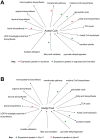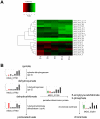Genome-wide transcriptional profiling of appressorium development by the rice blast fungus Magnaporthe oryzae
- PMID: 22346750
- PMCID: PMC3276559
- DOI: 10.1371/journal.ppat.1002514
Genome-wide transcriptional profiling of appressorium development by the rice blast fungus Magnaporthe oryzae
Abstract
The rice blast fungus Magnaporthe oryzae is one of the most significant pathogens affecting global food security. To cause rice blast disease the fungus elaborates a specialised infection structure called an appressorium. Here, we report genome wide transcriptional profile analysis of appressorium development using next generation sequencing (NGS). We performed both RNA-Seq and High-Throughput SuperSAGE analysis to compare the utility of these procedures for identifying differential gene expression in M. oryzae. We then analysed global patterns of gene expression during appressorium development. We show evidence for large-scale gene expression changes, highlighting the role of autophagy, lipid metabolism and melanin biosynthesis in appressorium differentiation. We reveal the role of the Pmk1 MAP kinase as a key global regulator of appressorium-associated gene expression. We also provide evidence for differential expression of transporter-encoding gene families and specific high level expression of genes involved in quinate uptake and utilization, consistent with pathogen-mediated perturbation of host metabolism during plant infection. When considered together, these data provide a comprehensive high-resolution analysis of gene expression changes associated with cellular differentiation that will provide a key resource for understanding the biology of rice blast disease.
Conflict of interest statement
The authors have declared that no competing interests exist.
Figures





References
-
- Wilson RA, Talbot NJ. Under pressure: investigating the biology of plant infection by Magnaporthe oryzae. Nat Rev Microbiol. 2009;7:185–195. - PubMed
-
- Skamnioti PGS. Against the grain: safeguarding rice from rice blast disease. Trends Biotechnol. 2009;27:141–150. - PubMed
-
- Dean RA, Talbot NJ, Ebbole DJ, Farman ML, Mitchell TK, et al. The genome sequence of the rice blast fungus Magnaporthe grisea. Nature. 2005;434:980–986. - PubMed
-
- Tucker SL, Talbot NJ. Surface attachment and pre-penetration stage development by plant pathogenic fungi. Annu Rev Phytopathol. 2001;39:385–417. - PubMed
-
- de Jong JC, McCormack BJ, Smirnoff N, Talbot NJ. Glycerol generates turgor in rice blast. Nature. 1997;389:244–244.
Publication types
MeSH terms
Substances
Associated data
- Actions
- Actions
- Actions
Grants and funding
LinkOut - more resources
Full Text Sources
Molecular Biology Databases
Research Materials

